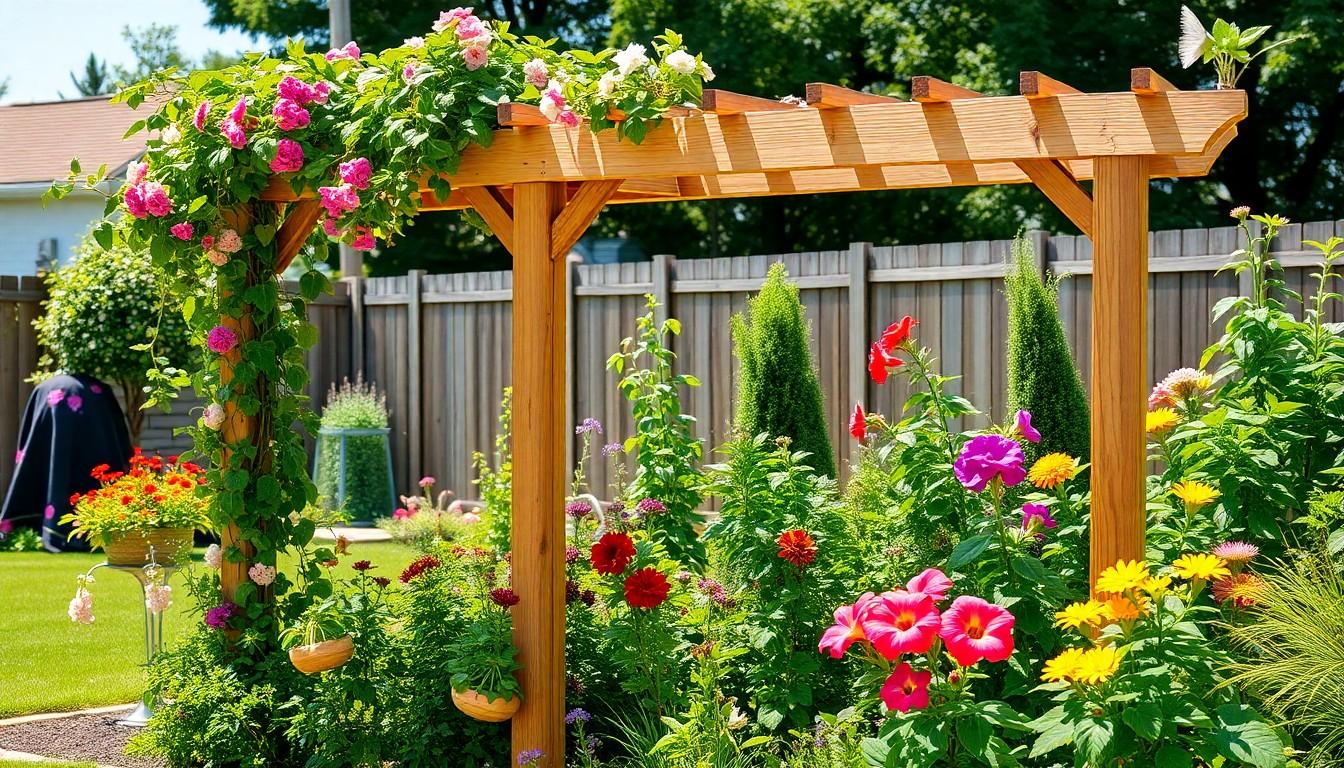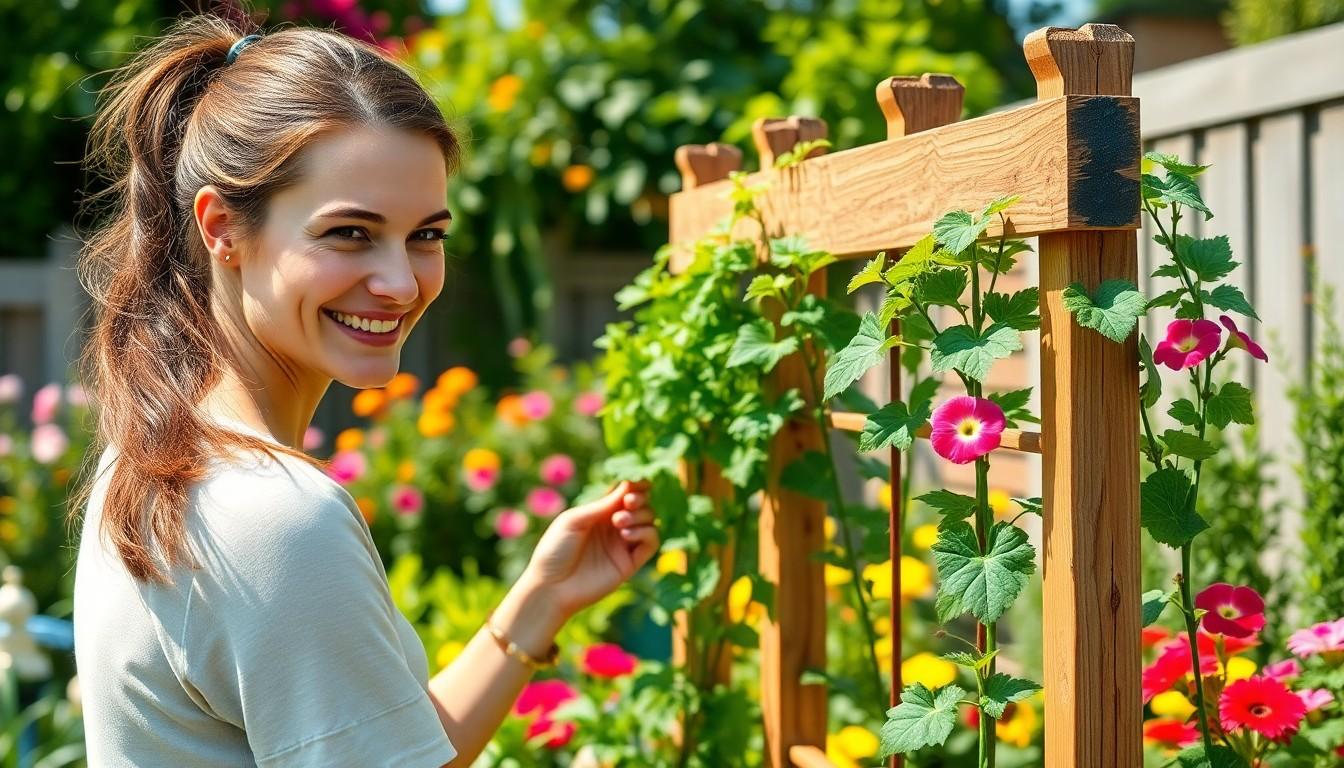Imagine a garden where plants grow tall and proud, reaching for the sun like they’re auditioning for a role in a nature documentary. Enter the gardening trellis, the unsung hero of the green world. It’s not just a pretty face; it’s the backbone of vertical gardening, allowing vines to climb and flowers to flourish. Who wouldn’t want to give their plants a lift?
Overview Of Gardening Trellis
A gardening trellis serves as a crucial component of vertical gardening. This structure supports climbing plants, allowing them to reach greater heights while optimizing sunlight exposure. Different materials, such as wood, metal, or plastic, form trellises, enhancing both function and aesthetics in gardens.
Measurements typically range from 3 to 8 feet in height, depending on the plants being supported. Various designs exist, including arched, panel, and lattice trellises, catering to different garden styles. A gardener can also customize trellises to align with specific plant types, optimizing growth conditions.
Plant selection influences the type of trellis used. Vines like peas and cucumbers thrive on sturdy trellises. Flowering plants such as clematis or morning glories add visual interest and color. Establishing a trellis early in the growing season promotes better plant health and easier maintenance.
Positioning of the trellis matters significantly. A south-facing location ensures maximum sunlight for greedy climbers. Additionally, spacing between plants should allow air circulation, reducing disease risk.
Maintenance includes regular checks for damage or instability. Treatments for wooden trellises can prolong their lifespan. Inspecting the trellis during the growing season promotes healthier plants and attractive garden appearances.
Using a gardening trellis maximizes space in smaller gardens. It encourages vertical growth, which can create a lush, dense look in constrained areas. Gardeners often find that employing trellises elevates plant varieties and enhances the overall beauty of their outdoor spaces.
Benefits Of Using A Gardening Trellis

Gardening trellises offer multiple advantages for garden enthusiasts. These structures support plants, contributing to healthier growth and vibrant gardens.
Improved Plant Growth
Trellises facilitate plant growth by providing structure for climbing species. Enhanced light exposure occurs as plants grow upwards instead of spread across the ground. Supporting climbing vines and flowering plants leads to stronger, more vigorous growth. Additionally, improved air circulation around the foliage decreases moisture accumulation, significantly reducing disease risk. The overall health of the garden benefits from these elements working together, ensuring bountiful blooms and fruitful yields.
Space Maximization
Efficient use of garden space emerges with a trellis in place. Placing plants vertically creates additional growing space in smaller gardens, allowing more plants to thrive in limited areas. Vertical gardening techniques encourage layering, maximizing the variety of plants grown in confined areas. Trellises also minimize ground-level congestion, making maintenance easier. Access to other plants becomes simpler, and harvesting becomes more efficient. The result is a flourishing garden that maximizes every square foot.
Types Of Gardening Trellis
Gardening trellises come in various types, with distinct materials and designs that cater to specific gardening needs.
Wooden Trellises
Wooden trellises offer a classic aesthetic, blending beautifully with natural landscapes. Typically made from cedar, pine, or redwood, they provide durability and resistance to decay. Heights often range from 5 to 8 feet, allowing climbing plants ample support. Gardeners appreciate their versatility; wooden trellises suit both flowering vines and vegetables like tomatoes. Regular maintenance, such as staining or sealing, prolongs lifespan. For those looking for a rustic charm, wooden trellises enhance garden beauty while supporting plant growth.
Metal Trellises
Metal trellises present a modern option for vertical gardening, often crafted from aluminum or wrought iron. These materials ensure strength and longevity, resisting rust and deterioration. Available in diverse styles, including geometric and ornate designs, they accommodate a wide variety of plants. Heights typically span from 4 to 7 feet, making them suitable for vigorous climbers. Installation remains straightforward, with many designs able to stand independently or attach to walls. For gardeners valuing both form and function, metal trellises deliver lasting support with minimal upkeep.
Plastic Trellises
Plastic trellises provide an affordable and lightweight solution for gardening needs. Made from durable polypropylene or PVC, they withstand weathering and UV rays. Heights usually vary from 3 to 6 feet, making them suitable for many climbing plants. Their flexibility allows for easy shaping and installation; these trellises can easily be moved or adjusted as plants grow. Available in various colors and styles, plastic trellises cater to unique design preferences. Eco-friendly options also exist, making them suitable for environmentally conscious gardeners aiming for sustainable practices.
How To Choose The Right Gardening Trellis
Selecting the right gardening trellis involves understanding various factors that contribute to optimal plant support and garden aesthetics.
Consider Your Plant Type
Plant types influence trellis choice significantly. Climbing vines, such as clematis and sweet peas, require sturdy trellises for optimal growth. Flowering plants like morning glories thrive on lightweight structures. Vegetable plants, including tomatoes and cucumbers, also benefit from specific trellis designs. For instance, a sturdy wooden or metal trellis works well for heavier crops. Evaluate the growth habits and weight of plants before finalizing your choice. Tailoring the trellis to the specific needs of plant species ensures successful vertical growth and healthy yields.
Evaluate Your Garden Space
Garden space plays a crucial role in trellis selection. Determine the available area for vertical structures, especially in smaller gardens. Positioning the trellis strategically maximizes sunlight and air circulation. Measure the height and width of the available space to ensure proper fit. Consider designs that complement your garden style, such as arched trellises for a whimsical touch. Furthermore, assess the distance between plants to maintain ease in maintenance and harvesting. Finding the right balance between aesthetics and functionality leads to an organized and thriving garden environment.
Maintenance Tips For Gardening Trellis
Regular inspections ensure the longevity of a gardening trellis. Check for signs of wear, particularly on wooden structures, where rot may develop. Treat any damaged areas immediately using a wood preservative to prevent further deterioration.
Cleaning plays a vital role in maintenance. Remove debris, such as leaves and dirt, that can accumulate over time. A soft brush or a gentle stream of water works effectively to keep the trellis clean.
Reinforcement may be necessary for trellises supporting heavier plants. Installing additional supports or stakes can provide extra stability. Ensuring the posts are anchored securely in the ground prevents leaning or toppling in adverse weather.
Seasonal upkeep enhances performance. Inspect the trellis after each growing season, noting any needed repairs or adjustments. Addressing these issues promptly maintains the structure’s integrity and aesthetic appeal.
Painting or staining wooden trellises protects them from moisture and pests. Using exterior-grade paint or stains offers durability against the elements. Reapplication occurs every few years, promoting a fresh look while providing necessary protection.
Proper plant care influences trellis maintenance as well. Ensure climbing plants receive regular pruning to prevent overgrowth that leads to entanglement. This practice promotes healthy growth and eases access for maintenance tasks.
Monitoring for pests also contributes to maintenance routines. Inspect plants for signs of infestations, such as discolored leaves or unusual spots. Applying organic pesticides promptly reduces the risk of damage to both plants and the trellis.
Storing unused trellises properly during off-seasons maintains their quality. Disassembling and storing them in a dry, sheltered location prevents exposure to harsh weather, prolonging their lifespan.
Conclusion
A gardening trellis is more than just a support structure; it’s a vital component that transforms any garden into a flourishing space. By promoting vertical growth and enhancing light exposure, trellises play a crucial role in cultivating healthier plants.
With various materials and designs available, gardeners can choose the perfect trellis to match their style and plant needs. Proper positioning and maintenance ensure these structures remain functional and beautiful throughout the seasons.
Incorporating a trellis not only maximizes space but also elevates the overall aesthetics of the garden, making it a worthwhile investment for any gardening enthusiast.

